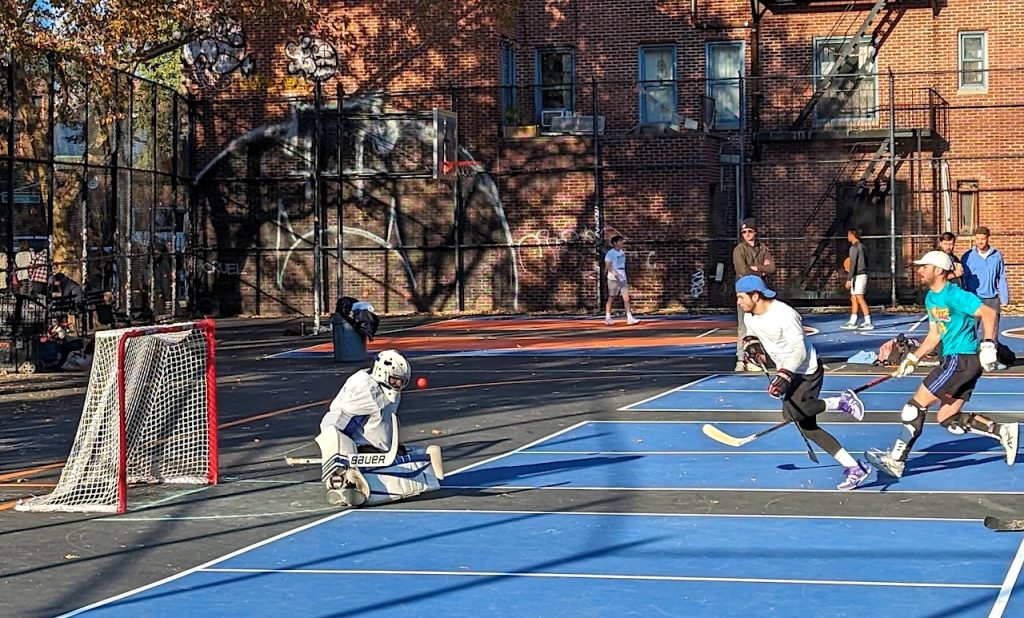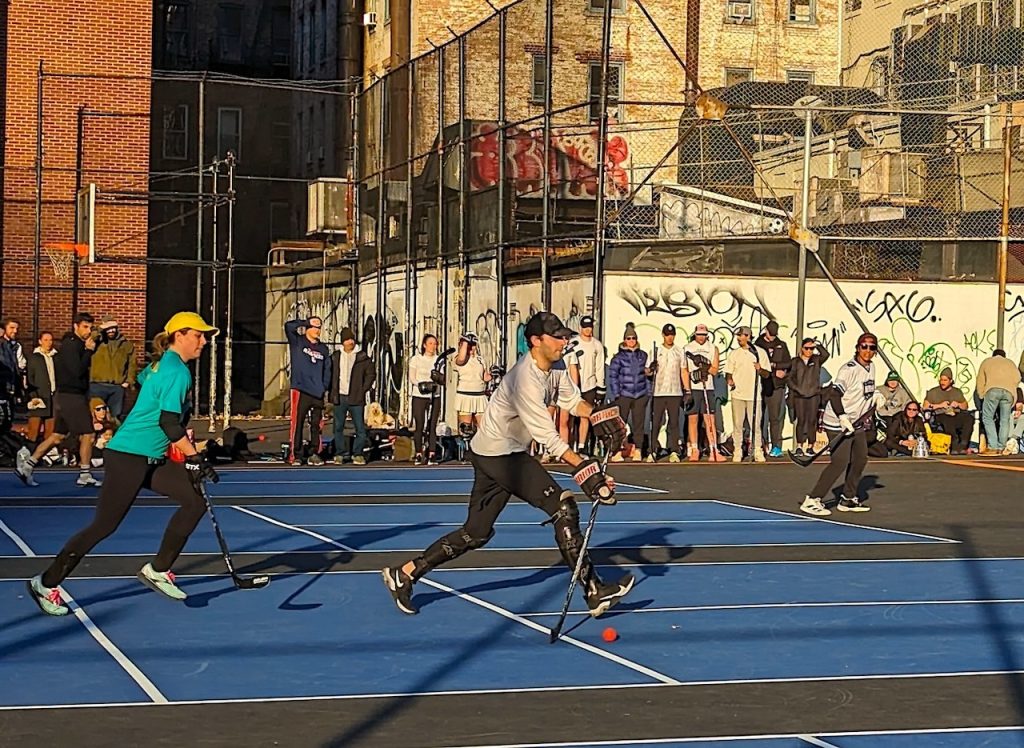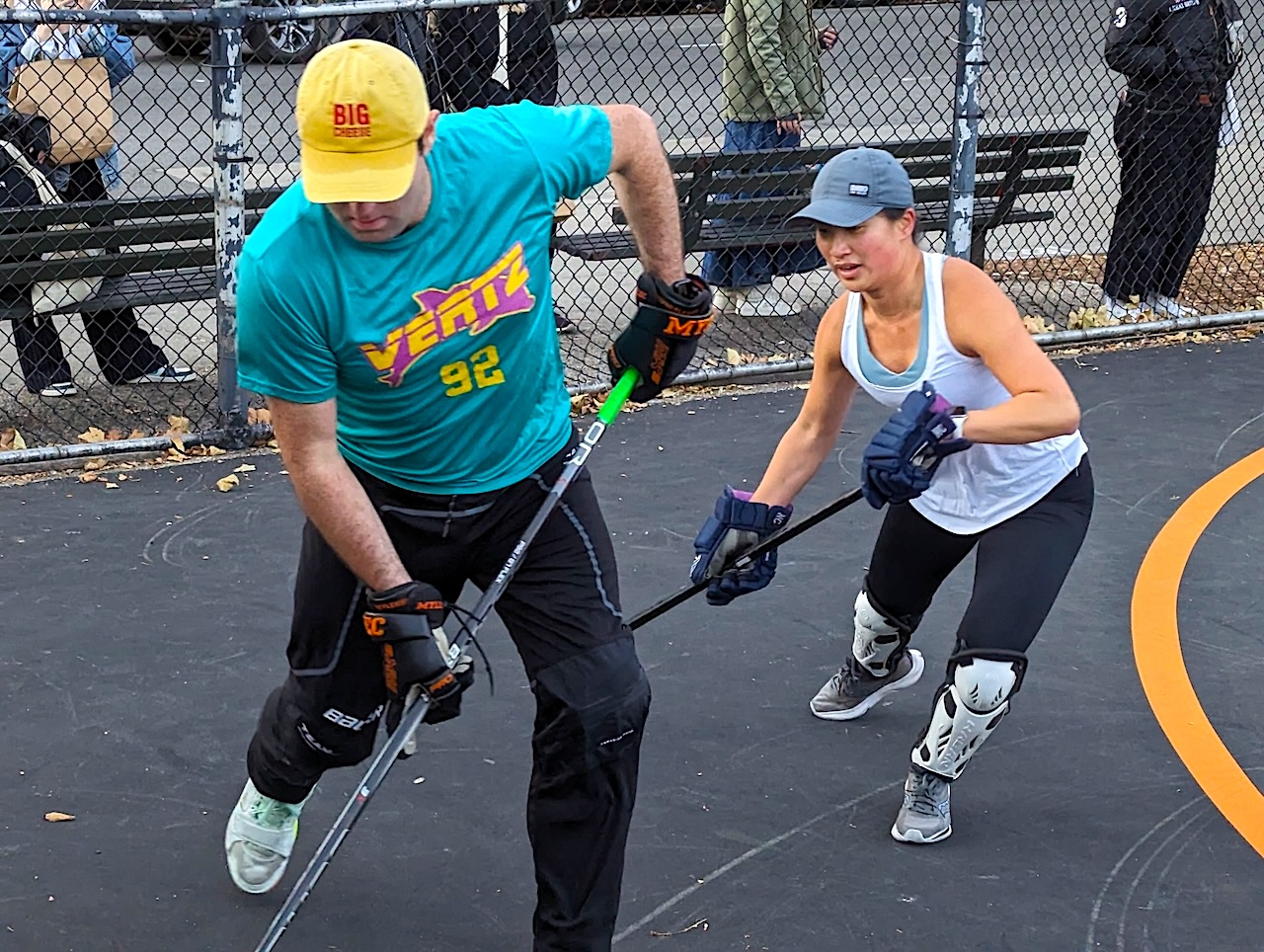BY AVERY HENDRICK | A Fresh Kills player yelled out from the make-shift street hockey “rink”: “Oh, yeah? Come fight me, then!”
Meanwhile, the game raged on, the neon orange ball zinging from one end of the court to the other.
It was the playoffs of the Black Top Street Hockey League and tensions were high.
“I will! I’m not afraid to burn a few bridges!” a Fuzz player on the sidelines yelled back at him.
It looked like the two were going to fight until a few brave teammates stepped between them and defused the situation with a few chirps — hockey speak for teasing — and laughs.
The backstory was that Fuzz’s “best player” had been prevented from playing in the team’s quarterfinal elimination game, after it was revealed he did not play enough regular season games.
In response, Fuzz made one of Fresh Kills’ players, who also had regular season attendance issues, sit out. However, in Fresh Kills’ case, this player was a woman, and losing her meant the team did not have enough female players on the field. As a result, Fresh Kills had to play the entire game down a player. From there, antagonism grew until shouting erupted during the game.
“It’s not normally like this,” laughed Fuzz’s Rich Glanzer. A league veteran, he’s a B.T.S.H. superstar organizer. “Usually we’re a very chill league.”

Black Top Street Hockey, New York City’s self-dubbed “OG street hockey league,” started in 2000 and prides itself on being co-ed, inclusive, beginner-friendly and non-contact. There are 20 teams in four divisions. Each game is 50 minutes with a halftime and a running clock. Since the league is co-ed, each team must have two women on the court at all times. Usually, B.T.S.H. plays in Tompkins Square Park on Sundays but recently has been relocated to William Passannante ballfield at Houston Street and Sixth Avenue due to construction.
As the league historian, Glanzer prides himself on his knowledge of the players, teams and rules.
“I’ve been playing hockey since 1991 and it had gotten a little tough in men’s league as I got older. So I started competing against these kids,” he joked.
He started in B.T.S.H. in 2008 after hearing about the league while playing broomball, which is played on ice in shoes rather than skates and with brooms instead of hockey sticks.
“Someone told me about this league and I tried out,” he said. “I didn’t make it. Actually, like, no team wanted me. But there was a free-agent team, and whoever paid $100 the fastest got in. And I paid the fastest. But I lived out on Long Island and I was coming from, like, 90 minutes away. I showed up and played one game and I didn’t think I was going to play again because it was too far away, but after that first game, I was hooked.”
Back then, Glanzer’s team, now Fuzz, was called the Elves. They are the only team to ever win the B.T.S.H. championship three times in a row.
“It’s one of the top 10, probably top five moments of my life,” he said.
This year, Fuzz was vying for another championship, even though Glanzer had slowed down a little bit. Joining him on the team was Amanda Fazio, one of the league’s commissioners. B.T.S.H. isn’t run by one person, but three, elected every two years by league members.

This year, second-time commissioner Russ Hamilton was joined by B.T.S.H. regulars Fazio and Courtney Pensavalle. They all arrange the schedule, obtain park passes, write press for the league, e-mail team captains and referee games.
“I’ve been in the league for four years and we needed someone to step up,” Pensavalle said. “So I ran because I’m super-invested and grateful for this league.”
Like many people in B.T.S.H., she’s a former Division 1 ice hockey player.
Her first game “was hysterical but also really fun,” she recalled. “I hadn’t put skates on in over a year and I hadn’t touched a stick, so I was looking to kind of heal my relationship with hockey. It was so fun.”
Looking around the playground, just about every type of person was in attendance to watch or play hockey. Many players brought their family, friends and children. Despite the competitiveness between Fresh Kills and Fuzz on the blacktop, chatter and hugs were common along the sidelines. Even after games ended, players stuck around to watch other teams play, and goalies shared tips about how to slide on their new court, which, they said, was rougher than at Tompkins.
Hamilton, who joined the league after walking up to a B.T.S.H. team in Tompkins and asking if they needed a sub, was drawn into helping run the league because he was inspired by this culture of community.
“This league gave a lot to me,” he said. “Really, it’s about the friends and the community and being here on Sunday and being around the people that you love. It’s like a nondenominational church of hockey.”
Today, Hamilton plays on Cobra Kai, who are still in the playoffs and, according to him, have the best goalie in the league.
“If my goalie is better than your goalie, then I win,” he said.
Back on the “rink,” the referee blew his whistle for halftime. He pulled the two captains into a private meeting mid-rink, warning them to keep their teams under control. Refs are only paid $20 a game. Most are current and former league members.
In the second half, the shorthanded Fresh Kills fought hard, getting within 2. But Fuzz prevailed, 7-3, advancing to the semifinals.
The game’s tensions were soon forgotten as the teams moved on to some light drinking and casual chirping of the teams in the next game.
“That’s the best thing about this league,” said Glanzer, naturally happy with his team’s win. “After games, when we go to a bar, you can see eight people from eight different teams hanging out. People go on vacation with guys on other teams. That’s really everything.”
Everything, of course, except for the PBR Cup, the Black Top Street Hockey championship trophy. Though the league is not sponsored by Pabst Blue Ribbon, their trophy is made of old cans and cases of the cheap beer.
“Actually, yeah,” Glanzer said, with a laugh, “the cup’s better than the Stanley Cup, probably, because of what it means to the community and the members.”


Be First to Comment